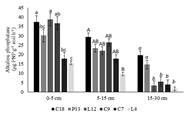ABSTRACT
The tropical dry areas have suffered the most severe anthropic pressures. This factor motivates studies aimed at characterizing and monitoring the soil quality to determine the management measures to apply and to suggest appropriate recovery procedures. The objective of this study was to evaluate the enzymatic activity of acid and alkaline phosphatases, urea and arylsulfatase in the superficial layers of soils in areas under different stages of forest regeneration, in Floresta-PE City.. Soil sampling was conducted at 0-5, 5-15 and 15-30 cm layer in the following areas: C-18 (vegetation regeneration for 18 years), P-13 (13 years), L-12 (12 years), C-9 (9 years), C-7 (7 years) and G-4 (4 years). The analytical methods used in the study were based on the incubation of the soil samples with a buffered solution of substrate specific for each enzyme. The methods were based on colorimetric determinations. The activity of acid and alkaline phosphatase and urease represented sensitive measures for detecting changes in soil quality at various stages of regeneration in tropical dry forests. The area with the longest duration of forest regeneration (C-18) showed higher enzyme activities. The soil enzymatic activities respond to different stages and management of forest regeneration in Brazilian tropical dry areas, namely Caatinga. The acid and alkaline phosphatase, arylsulfatase and urease increased with time of regeneration.
Keywords:
Extracelular soil enzymes; Soil quality; Phosphatase; Urease; Arylsulfatase

 Thumbnail
Thumbnail
 Thumbnail
Thumbnail
 Thumbnail
Thumbnail
 Thumbnail
Thumbnail
 Thumbnail
Thumbnail




